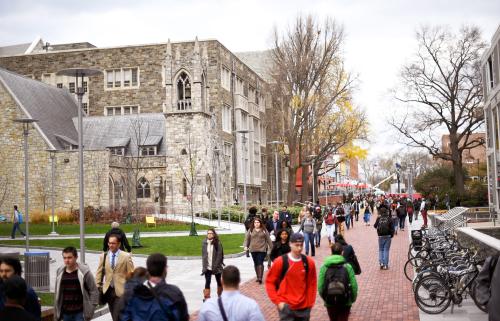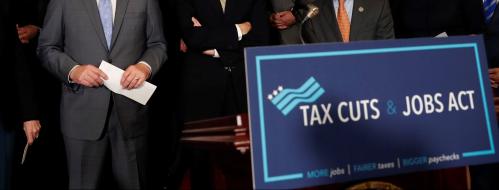If you want more content like this, subscribe to our newsletter.
This week in Class Notes:
-
- Limits on college class sizes negatively affect outcomes for community college students.
- Billionaires’ geographical location is highly responsive to state estate taxes. However, the benefit of the tax still exceeds the cost for most states.
- Higher minimum wages increase family incomes and decrease reliance on public assistance for those at the bottom of the income distribution.
- Our top chart shows the effect of the post-TCJA (Tax Care and Jobs Act) income tax on the poverty rate.
- Keeanga-Yamahtta Taylor explores the history of racial inequality in our housing market.
- Finally, check out John Bridgeland and John Dilulio’s new piece for us examining the case for national service. Also, be sure to watch the footage from our recent National Service event.
The effect of course shutouts on community college students: Evidence from waitlist cutoffs
One important channel through which money affects college students is course availability—colleges may respond to budgetary pressure by limiting course offerings. Open admissions policies, class size constraints, and heavy reliance on state funding may make this a particular issue at community colleges. In this paper, Robles et al. use course registration data to study the effect of class size constraints on the behavior of community college students. The authors find that students placed on a waitlist for a course section were 25% more likely to take zero courses that semester relative to baseline of 10%. Shutouts were also shown to increase transfer rates to nearby, but potentially lower-quality, two-year colleges. These results suggest that limited course availability can negatively affect community college students’ educational trajectories.
Taxing billionaires: Estate taxes and the geographical location of the ultra-wealthy
Do the super-rich flee from higher taxes? Moretti et al. address this topical question by examining the effect of state-level estate taxes on the geographical location of the 400 richest Americans according to Forbes. Exploiting a 2001 change in federal tax law, the authors find that the number of Forbes 400 individuals in states levying an estate tax fell 30% after 2001, as compared to states without an estate tax. The sensitivity of billionaires to estate taxes is also shown to increase significantly with age. Looking at the implications of these findings for tax policy, Moretti et al. compare the one-time revenue gain when a wealthy resident dies—$165 million on average—with the foregone income tax revenues over the remaining lifetime of those who relocate. Despite the high estimated tax mobility of billionaires, the authors find that the benefit of an estate tax exceeds the cost for most states.
Minimum wages and the distribution of family incomes
In this paper, Arindrajit Dube uses individual-level population data to provide a comprehensive picture of how U.S. minimum wage policies shift the distribution of family incomes (for the non-elderly population). Overall, the evidence clearly points to at least moderate income gains for low income families arising from an increase in the minimum wage. At the same time, there is evidence of some substitution of government transfers with earnings, as illustrated by the smaller income increase if tax credit and non-cash transfers such as SNAP and EITC are taken into account.
Top chart
This week’s top chart shows the estimated reduction in the poverty rate attributable to the post-TCJA income tax and several low-income assistance programs: the Supplemental Nutrition Assistance Program (SNAP); Supplemental Security Income (SSI); assisted housing programs; and Temporary Assistance for Needy Families (TANF). Only SNAP resulted in a reduction in the overall poverty rate comparable to the post-TCJA income tax.

Choice opinion
“The public-private partnership in the production of low-income housing the 1970s tethered the public agencies of HUD and the F.H.A to real estate brokers, mortgage bankers and homebuilders. These close relationships made it unlikely that anti-discrimination laws would be aggressively enforced. This allowed banks and real estate agents to continue to illegally steer black buyers away from neighborhoods with better housing at better prices…Racial discrimination persisted in the new market because it was good business, not simply because the industry was stuck in its old ways…At the very least, Washington must renew its commitment to aggressively enforce its own civil rights laws and ruthlessly punish offenders. This could finally undo the ways in which racial inequality has continued to find value in our housing market” writes Keeanga-Yamahtta Taylor in the New York Times.
Self-promotion
There are growing concerns that America’s civic health is declining. Institutions that were once the glue of tight-knit American communities—churches, unions, and political parties—are declining or changing rapidly. At a time when the country is becoming more politically divided, new efforts are necessary to bridge the divide and restore a universal sense of community and belonging. In a new paper “Will America embrace national service?“, John Bridgeland and John Dilulio argue that expanded national service can connect and engage Americans from different economic, racial, and geographic backgrounds, while instilling values of civic responsibility, leadership, and commitment to country.
If you prefer to watch and listen, see the footage from our October 10th event, which features Joe Heck, Jesse Colvin, Barbara Stewart, and others discussing the role of national service in American society.








Commentary
Class Notes: Taxing billionaires, college course availability, and more
Wednesday, October 30, 2019